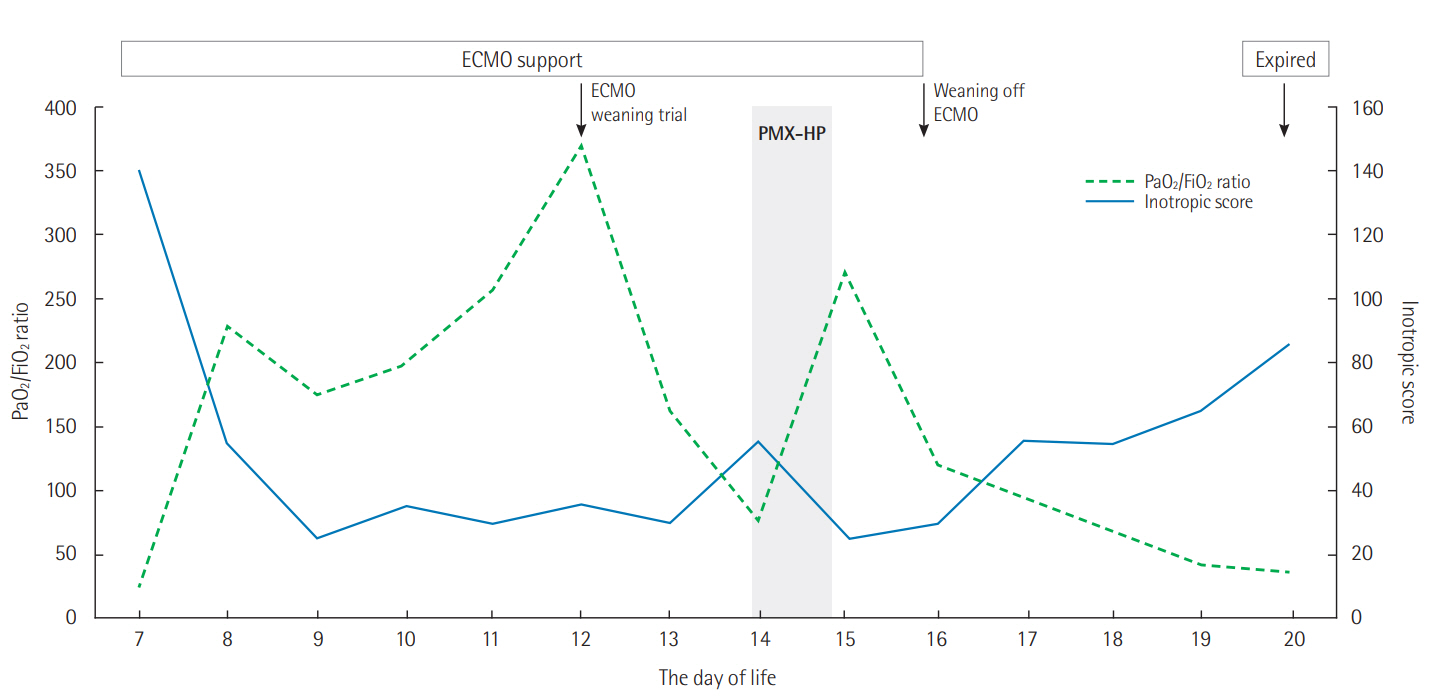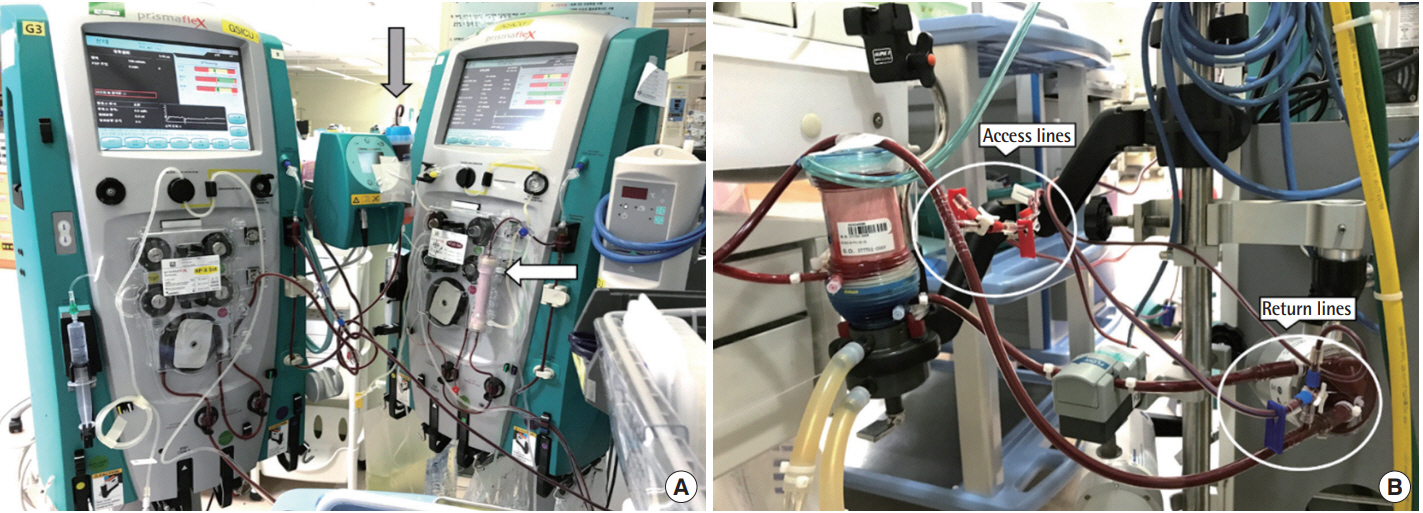Acute Crit Care.
2019 Nov;34(4):284-288. 10.4266/acc.2017.00528.
A successful application of adult polymyxin B-immobilized fiber column hemoperfusion to a neonate with septic shock
- Affiliations
-
- 1Department of Pediatrics, Pusan National University Children’s Hospital, Yangsan, Korea. youngflo@hanmail.net
- 2Department of Thoracic and Cardiovascular Surgery, Pusan National University Yangsan Hospital, Yangsan, Korea.
- 3Department of Artificial Kidney Unit, Pusan National University Yangsan Hospital, Yangsan, Korea.
- KMID: 2467309
- DOI: http://doi.org/10.4266/acc.2017.00528
Abstract
- Direct hemoperfusion therapy with a polymyxin B-immobilized fiber column (PMX-HP) has been introduced as a therapeutic option for gram negative bacterial septic shock in adults. However, its use in neonates and children has not yet been established. We successfully performed hemoperfusion therapy using an adult polymyxin B-immobilized fiber column in a neonate with carbapenem resistant Acinetobacter baumannii septic shock. The application was technically feasible because the neonate was on extracorporeal membrane oxygenation (ECMO). Although it did not rescue the patient, there was significant short-lasting improvement in pulmonary oxygenation and hemodynamics, leading to wean the patient from ECMO. PMX-HP could be used as an adjunctive treatment for selected neonatal and pediatric patients with gram negative bacterial septic shock.
MeSH Terms
Figure
Cited by 2 articles
-
Controlling an Outbreak of Multidrug-resistant
Acinetobacter baumannii in a Pediatric Intensive Care Unit: a Retrospective Analysis
Joung-Hee Byun, Su Eun Park, Minhae Seo, Jeungmi Jang, Mi Sun Hwang, Ju Yeoun Song, Chulhun L. Chang, Young A Kim
J Korean Med Sci. 2021;36(46):e307. doi: 10.3346/jkms.2021.36.e307.Suggestions and tips regarding polymyxin B-immobilized fiber column direct hemoperfusion of neonates with sepsis
Naoto Nishizaki
Acute Crit Care. 2020;35(3):226-227. doi: 10.4266/acc.2020.00241.
Reference
-
References
1. Cruz DN, Perazella MA, Bellomo R, de Cal M, Polanco N, Corradi V, et al. Effectiveness of polymyxin B-immobilized fiber column in sepsis: a systematic review. Crit Care. 2007; 11:R47.
Article2. Cruz DN, Antonelli M, Fumagalli R, Foltran F, Brienza N, Donati A, et al. Early use of polymyxin B hemoperfusion in abdominal septic shock: the EUPHAS randomized controlled trial. JAMA. 2009; 301:2445–52.3. Mitaka C, Tomita M. Polymyxin B-immobilized fiber column hemoperfusion therapy for septic shock. Shock. 2011; 36:332–8.
Article4. Shoji H, Tani T, Hanasawa K, Kodama M. Extracorporeal endotoxin removal by polymyxin B immobilized fiber cartridge: designing and antiendotoxin efficacy in the clinical application. Ther Apher. 1998; 2:3–12.
Article5. Machado JR, Soave DF, da Silva MV, de Menezes LB, Etchebehere RM, Monteiro ML, et al. Neonatal sepsis and inflammatory mediators. Mediators Inflamm. 2014; 2014:269681.6. Hussein MH, Kato T, Sugiura T, Daoud GA, Suzuki S, Fukuda S, et al. Effect of hemoperfusion using polymyxin B-immobilized fiber on IL-6, HMGB-1, and IFN gamma in a neonatal sepsis model. Pediatr Res. 2005; 58:309–14.
Article7. Tani T, Hanasawa K, Kodama M, Imaizumi H, Yonekawa M, Saito M, et al. Correlation between plasma endotoxin, plasma cytokines, and plasminogen activator inhibitor-1 activities in septic patients. World J Surg. 2001; 25:660–8.
Article8. Hirakawa E, Ibara S, Tokuhisa T, Hiwatashi S, Hayashida Y, Maede Y, et al. Septic neonate rescued by polymyxinB hemoperfusion. Pediatr Int. 2013; 55:e70–2.9. Maede Y, Ibara S, Tokuhisa T, Ishihara C, Hirakawa E, Matsui T, et al. Polymyxin B-immobilized fiber column direct hemoperfusion and continuous hemodiafiltration in premature neonates with systemic inflammatory response syndrome. Pediatr Int. 2016; 58:1176–82.
Article10. Pollack MM, Patel KM, Ruttimann UE. PRISM III: an updated pediatric risk of mortality score. Crit Care Med. 1996; 24:743–52.11. Wernovsky G, Wypij D, Jonas RA, Mayer JE Jr, Hanley FL, Hickey PR, et al. Postoperative course and hemodynamic profile after the arterial switch operation in neonates and infants: a comparison of lowflow cardiopulmonary bypass and circulatory arrest. Circulation. 1995; 92:2226–35.12. Tani T, Shoji H, Guadagni G, Perego A. Extracorporeal removal of endotoxin: the polymyxin B-immobilized fiber cartridge. Contrib Nephrol. 2010; 167:35–44.
Article13. Ikeda T, Ikeda K, Nagura M, Taniuchi H, Matsushita M, Kiuchi S, et al. Clinical evaluation of PMX-DHP for hypercytokinemia caused by septic multiple organ failure. Ther Apher Dial. 2004; 8:293–8.
Article14. Takeyama N, Noguchi H, Hirakawa A, Kano H, Morino K, Obata T, et al. Time to initiation of treatment with polymyxin B cartridge hemoperfusion in septic shock patients. Blood Purif. 2012; 33:252–6.
Article15. Payen DM, Guilhot J, Launey Y, Lukaszewicz AC, Kaaki M, Veber B, et al. Early use of polymyxin B hemoperfusion in patients with septic shock due to peritonitis: a multicenter randomized control trial. Intensive Care Med. 2015; 41:975–84.
Article16. Iwagami M, Yasunaga H, Doi K, Horiguchi H, Fushimi K, Matsubara T, et al. Postoperative polymyxin B hemoperfusion and mortality in patients with abdominal septic shock: a propensity-matched analysis. Crit Care Med. 2014; 42:1187–93.17. Fujii T, Ganeko R, Kataoka Y, Furukawa TA, Featherstone R, Doi K, et al. Polymyxin B-immobilized hemoperfusion and mortality in critically ill adult patients with sepsis/septic shock: a systematic review with meta-analysis and trial sequential analysis. Intensive Care Med. 2018; 44:167–78.
Article
- Full Text Links
- Actions
-
Cited
- CITED
-
- Close
- Share
- Similar articles
-
- Up-to-date information on polymyxin B-immobilized fiber column direct hemoperfusion for septic shock
- A successful application of adult polymyxin B-immobilized fiber column hemoperfusion to a neonate with septic shock
- Refractory Septic Shock Treated with Nephrectomy under the Support of Extracorporeal Membrane Oxygenation
- Polymyxin B Immobilized Fiber Hemoperfusion in Refractory Intra-abdominal Septic Shock
- Polymyxin B Hemoperfusion in Pneumonic Septic Shock Caused by Gram-Negative Bacteria



